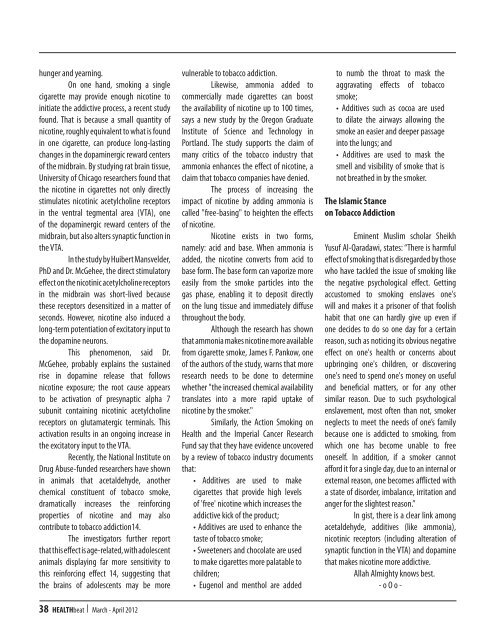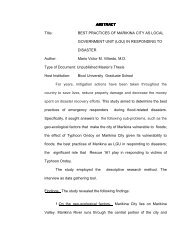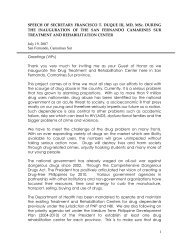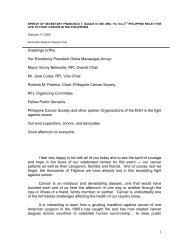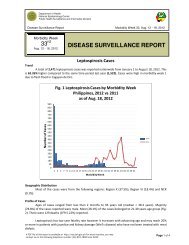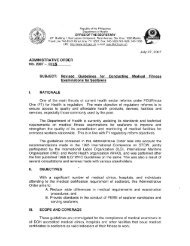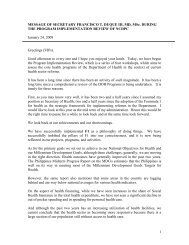Issue No. 69 - March - April 2012 - DOH
Issue No. 69 - March - April 2012 - DOH
Issue No. 69 - March - April 2012 - DOH
- No tags were found...
Create successful ePaper yourself
Turn your PDF publications into a flip-book with our unique Google optimized e-Paper software.
hunger and yearning.On one hand, smoking a singlecigarette may provide enough nicotine toinitiate the addictive process, a recent studyfound. That is because a small quantity ofnicotine, roughly equivalent to what is foundin one cigarette, can produce long-lastingchanges in the dopaminergic reward centersof the midbrain. By studying rat brain tissue,University of Chicago researchers found thatthe nicotine in cigarettes not only directlystimulates nicotinic acetylcholine receptorsin the ventral tegmental area (VTA), oneof the dopaminergic reward centers of themidbrain, but also alters synaptic function inthe VTA.In the study by Huibert Mansvelder,PhD and Dr. McGehee, the direct stimulatoryeffect on the nicotinic acetylcholine receptorsin the midbrain was short-lived becausethese receptors desensitized in a matter ofseconds. However, nicotine also induced along-term potentiation of excitatory input tothe dopamine neurons.This phenomenon, said Dr.McGehee, probably explains the sustainedrise in dopamine release that followsnicotine exposure; the root cause appearsto be activation of presynaptic alpha 7subunit containing nicotinic acetylcholinereceptors on glutamatergic terminals. Thisactivation results in an ongoing increase inthe excitatory input to the VTA.Recently, the National Institute onDrug Abuse-funded researchers have shownin animals that acetaldehyde, anotherchemical constituent of tobacco smoke,dramatically increases the reinforcingproperties of nicotine and may alsocontribute to tobacco addiction14.The investigators further reportthat this effect is age-related, with adolescentanimals displaying far more sensitivity tothis reinforcing effect 14, suggesting thatthe brains of adolescents may be morevulnerable to tobacco addiction.Likewise, ammonia added tocommercially made cigarettes can boostthe availability of nicotine up to 100 times,says a new study by the Oregon GraduateInstitute of Science and Technology inPortland. The study supports the claim ofmany critics of the tobacco industry thatammonia enhances the effect of nicotine, aclaim that tobacco companies have denied.The process of increasing theimpact of nicotine by adding ammonia iscalled "free-basing" to heighten the effectsof nicotine.Nicotine exists in two forms,namely: acid and base. When ammonia isadded, the nicotine converts from acid tobase form. The base form can vaporize moreeasily from the smoke particles into thegas phase, enabling it to deposit directlyon the lung tissue and immediately diffusethroughout the body.Although the research has shownthat ammonia makes nicotine more availablefrom cigarette smoke, James F. Pankow, oneof the authors of the study, warns that moreresearch needs to be done to determinewhether "the increased chemical availabilitytranslates into a more rapid uptake ofnicotine by the smoker."Similarly, the Action Smoking onHealth and the Imperial Cancer ResearchFund say that they have evidence uncoveredby a review of tobacco industry documentsthat:• Additives are used to makecigarettes that provide high levelsof 'free' nicotine which increases theaddictive kick of the product;• Additives are used to enhance thetaste of tobacco smoke;• Sweeteners and chocolate are usedto make cigarettes more palatable tochildren;• Eugenol and menthol are addedto numb the throat to mask theaggravating effects of tobaccosmoke;• Additives such as cocoa are usedto dilate the airways allowing thesmoke an easier and deeper passageinto the lungs; and• Additives are used to mask thesmell and visibility of smoke that isnot breathed in by the smoker.The Islamic Stanceon Tobacco AddictionEminent Muslim scholar SheikhYusuf Al-Qaradawi, states: “There is harmfuleffect of smoking that is disregarded by thosewho have tackled the issue of smoking likethe negative psychological effect. Gettingaccustomed to smoking enslaves one'swill and makes it a prisoner of that foolishhabit that one can hardly give up even ifone decides to do so one day for a certainreason, such as noticing its obvious negativeeffect on one's health or concerns aboutupbringing one's children, or discoveringone's need to spend one's money on usefuland beneficial matters, or for any othersimilar reason. Due to such psychologicalenslavement, most often than not, smokerneglects to meet the needs of one’s familybecause one is addicted to smoking, fromwhich one has become unable to freeoneself. In addition, if a smoker cannotafford it for a single day, due to an internal orexternal reason, one becomes afflicted witha state of disorder, imbalance, irritation andanger for the slightest reason.”In gist, there is a clear link amongacetaldehyde, additives (like ammonia),nicotinic receptors (including alteration ofsynaptic function in the VTA) and dopaminethat makes nicotine more addictive.Allah Almighty knows best.- o O o -38 HEALTHbeat I <strong>March</strong> - <strong>April</strong> <strong>2012</strong>


